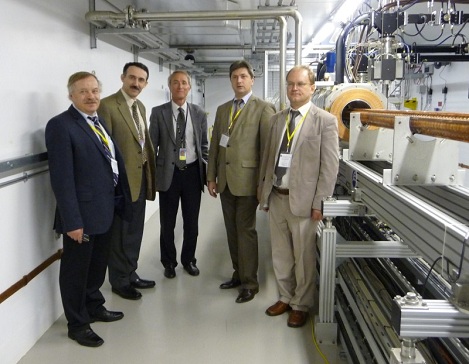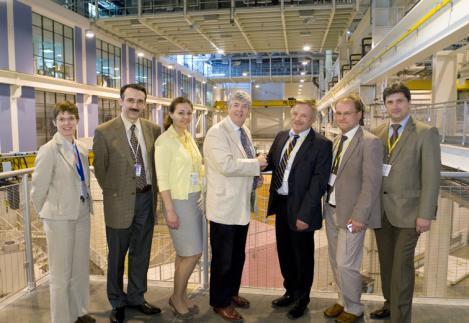JINR delegation visit to JAI
JINR delegation visit to JAI
The John Adams Institute for Accelerator Science has recently hosted the visit of a delegation from the Joint Institute of Nuclear Research (JINR, Russia) to UK on 26-28 April 2011.
JINR is an international intergovernmental scientific research organisation, which has 18 member states, and another 6 countries as associated members. The three main activities of JINR are elementary particle physics, nuclear physics, and condensed matter physics.
The delegation, led by the JINR Chief engineer Prof. Grigory Shirkov, and which included the Head of the International Cooperation Department (ICD) Dr. Dmitry Kamanin, the Director of the University Centre Prof. Stanislav Pakuliak and the ICD Coordinator Olga Matyukhina, visited Oxford, Harwell and Culham on 26-28 April 2011.
The visit was organised and hosted by JAI, within the framework of the JINR-JAI Agreement signed in February this year by Prof. Andrei Seryi, Director of the JAI, the University of Oxford, Royal Holloway University of London, and the JINR Directorate.
The scientific programme was aimed at exploration of opportunities for UK-Russia collaboration in accelerator research and other mutually interesting fields. Dr Michele Warren coordinated the activities with help from colleagues at the participating laboratories.
The visits and discussions at JAI and Oxford Department of Physics represented by Prof John Wheater, the Chairman of Physics, focused on discussions of potential joint work on accelerator projects including the future laser-plasma based X-ray laser, as well on accelerator training, which at JINR is coordinated by the University Centre.
The JINR delegation, accompanied by Prof Seryi, visited Diamond Light Source, where discussions with Prof Richard Walker, the Technical Director of DLS, and Prof Gerd Materlik, DLS Chief Executive, revolved around design of beamlines and storage rings, applicable to both future light sources in UK and JINR’s ion collider project NICA.

JINR delegation visiting Diamond Light Source (left to right): Grigory Shirkov (JINR), Andrei Seryi (JAI), Richard Walker (DLS), Dmitry Kamanin (JINR), Stanislav Pakuliak (JINR).
The JINR visit to ISIS and discussions with Dr. Andrew Taylor, the Director of ISIS, were naturally focused on neutron and muon sources, on the program of ISIS upgrade and of the accelerator based IREN and reactor-based IBR-2 neutron facilities at JINR.

JINR delegation visiting ISIS neutron source (left to right): Michele Warren (Oxford and JAI), Andrei Seryi (JAI), Olga Matyukhina (JINR), Andrew Taylor (ISIS), Grigory Shirkov (JINR), Stanislav Pakuliak (JINR), Dmitry Kamanin (JINR). Image courtesy of ST
Subsequent discussions led by Dr David Findlay, the head of ISIS Accelerator Division, concentrated on developments of the front ends of proton and ion linacs, with FETS (Front End Test Stand) — a generic test stand for technologies for high-power proton accelerators and a front end for an upgraded ISIS, presented by Alan Letchford — being an illustration of active UK research in the area.
A visit to the Chemistry Research Laboratory in Oxford was inspired by common interests in innovations – the success stories described by Prof Steve Davies, Chairman of Chemistry, was discussed in parallel with discussion of JINR experience in the Dubna Free Economic Zone as well as JINR and JAI joint plans with Skolkovo Foundation.
The JINR delegation, Prof Seryi and Dr Warren also visited the Culham Center for Fusion Energy, tours and discussions with Dr Michael Watkins, the Head of International Collaborations at JET, and Dr. Elizabeth Surrey, were focused, apart from fascination by the JET and MAST facilities, on the possible use of accelerator technologies in fusion research.
A meeting at the Gray Institute for Radiation Oncology and Biology with Prof Bleddyn Jones and Prof Boris Vojnovic revolved around the use of protons and ions for cancer therapy, the latest analysis of fast neutron radiobiology and about UK and Oxford plans of establishing the proton cancer therapy centres and about JINR’s 50year experience in this field in the JINR Laboratory of Radiation Biology.
The delegation also met with Prof John Womersley, the Director of Science Programmes for STFC, and had a chance to discuss the overall situation of the scientific collaboration between the two countries.
Last but not least, the cultural aspects of the visit were further enhanced by one of the Oxford May Music concerts, organised and hosted by Prof. Brian Foster, the head of sub-department of Particle Physics at the University of Oxford.
This visit will be followed by further collaborative steps aimed to enhance scientific-technical, innovation and educational co-operation between the two countries.




